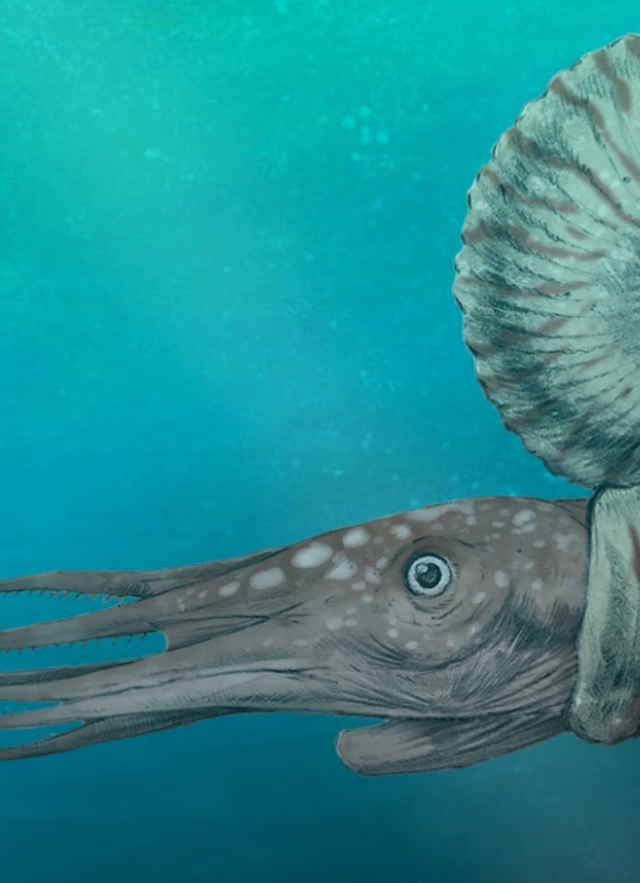The museum will be closed Thursday, January 1 for New Year's Day. We will reopen Friday, January 2.
Collections Staff Help Ammonites Come Out of Their Shells
Uncovering how digitization and collections management made a groundbreaking extinction study come to life

“It’s best to think of us like fossil librarians,” says Collections Manager Juliet Hook. “But instead of stewarding books, we're stewarding fossils that tell us a story about our world. I think it's really powerful to be a part of that process and it's impactful to bring in others so we can explore together.”
Hook manages an estimated 6–7 million specimens of prehistoric crabs, clams, sea urchins, corals, and other fossils of spineless creatures in the Invertebrate Paleontology collections at the Natural History Museum of Los Angeles County, where she cares for the fossilized invertebrates for posterity and scientific research. To non-paleontologists, no other invertebrate says ancient life like the mysterious and iconic ammonites.

Ammonites—those funky-shelled creatures from the Age of Dinosaurs—ranged in size from the 20 mm diameter Nannocardioceras of the Late Jurassic to nearly car-sized Parapuzosia seppenradensis in the Late Cretaceous. While many paleontologists thought these globe-spanning swimmers were on the decline before going extinct in the same catastrophic event that took out the dinosaurs, a recent paper in Nature Communications co-authored by NHM’s Invertebrate Paleontology Curator Austin Hendy lays the blame squarely on that asteroid, highlighting ammonites striking diversity across the globe ahead of that fateful impact.

Hook was not a co-author on the study, but the painstaking work of digitizing specimens by collections managers like her made the research possible. The researchers were only able to make the huge data sets necessary to compare global ammonite diversity with digitized data from museum collections like NHM’s.
“Digitization is this process of turning a physical object into electronic data, but in the world we live in now, we have the opportunities to share that data not with just researchers, but the public alike,” says Hook. While making that data locked in collections—what Hook calls ‘dark data’—available to communities across the globe opens up new possibilities in research and public outreach, it also makes it accessible to researchers who couldn’t afford the expense of visiting the museum, overcoming a long-standing barrier to accessibility. Thankfully, she doesn’t always do that work alone.

“Invertebrate paleontology really was something that I was drawn to from my interest in Marine Biology during college, but I never knew much about careers in museums until I was able to be a part of the program,” says Nicole McGee, former National Science Foundation Funded Post Baccalaureate Researcher and Occidental College summer intern as part of the Intern L.A. Program—the program that brought her into the collections.
McGee’s work in the collections was critical to building the data sets used in the study, a global atlas of ammonites during the Age of Dinosaurs. Like the millions of specimens within and across institutions, digitized collections are stored and cataloged in various sites, and they don’t necessarily talk to each other. “Much of the data we generate in our collection database ends up in iDigBio (a website that publicly shares digitized collection data), but also a lot of information is not necessarily available through the internet.” It’s work that McGee has carried forward into a Masters program in Museum and Field Studies at the University of Colorado Boulder where she’ll continue to focus on invertebrate fossil collections. “That availability on iDigBio and all those other website resources is something that I focus on now.”

McGee’s experience highlights the value of internships in museum collections for expanding the use of collections through processes like digitization. “A lot of that process involves having people like Nicole who get to come in and identify this material and then share those identifications with the world,” says Hook. “But at the same time, she is gaining that experience to build agency to do it herself and be a part of this science process. As Nicole said, we work a lot within our collections management system to create standards so that when we do share data, it's available to be usable and interpreted by all.”
While Hook and McGee continue to make museum collections available to scientists across the globe, they’re also bringing those vast stores of specimens to very important people closer to home. Both McGee and Hook relish sharing the wonders of those collections with Angelenos.

“I think that's one of the most impactful parts, especially being someone that can be the face that a kid sees. They can see themselves in my position when they come by the collection spaces, and they have a million questions,” says McGee. “It's always so fun to be there—and especially Juliet and I being two women in STEM. I think it means a lot to even be in the space with a badge. It’s really cool.”

For the future of museum research, raising awareness about the work happening inside collections is essential to growing the field, amplifying the importance of both youth outreach and internship opportunities. As digitization brings dark data into the light, it expands the value of museum collections to help answer ever-bigger questions about the past, present, and future of our world.
“It's why we're here, so it's never not fascinating,” says Hook.

